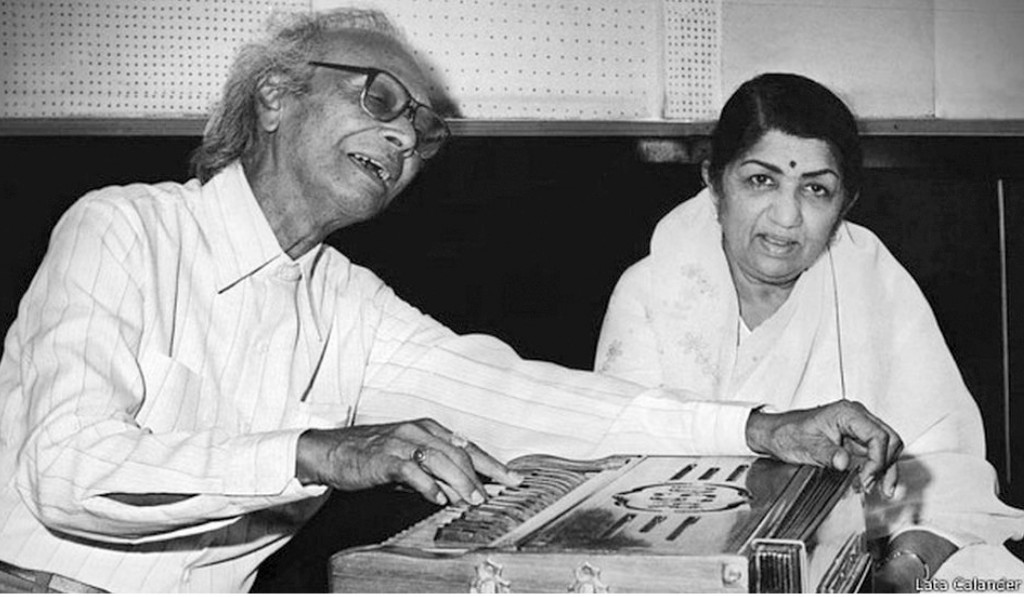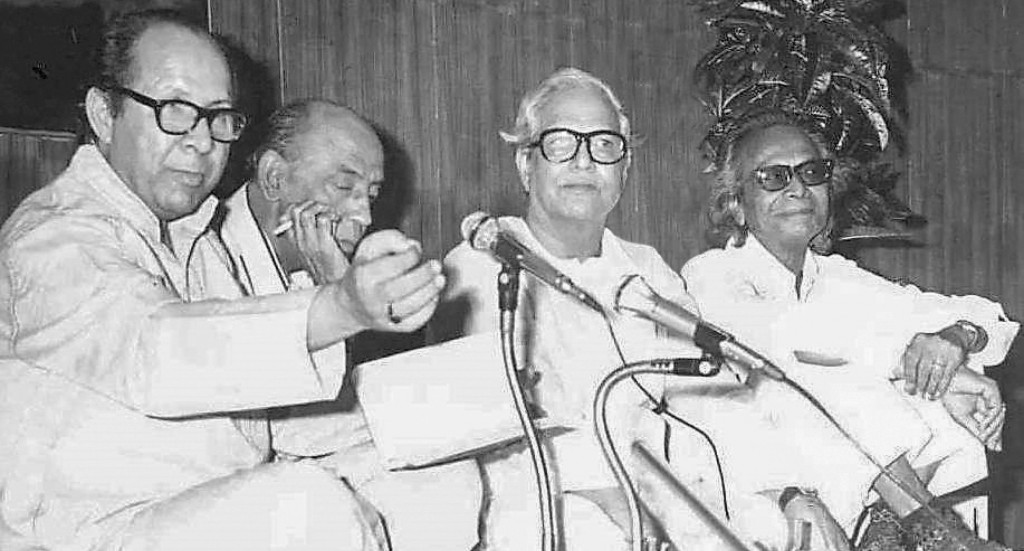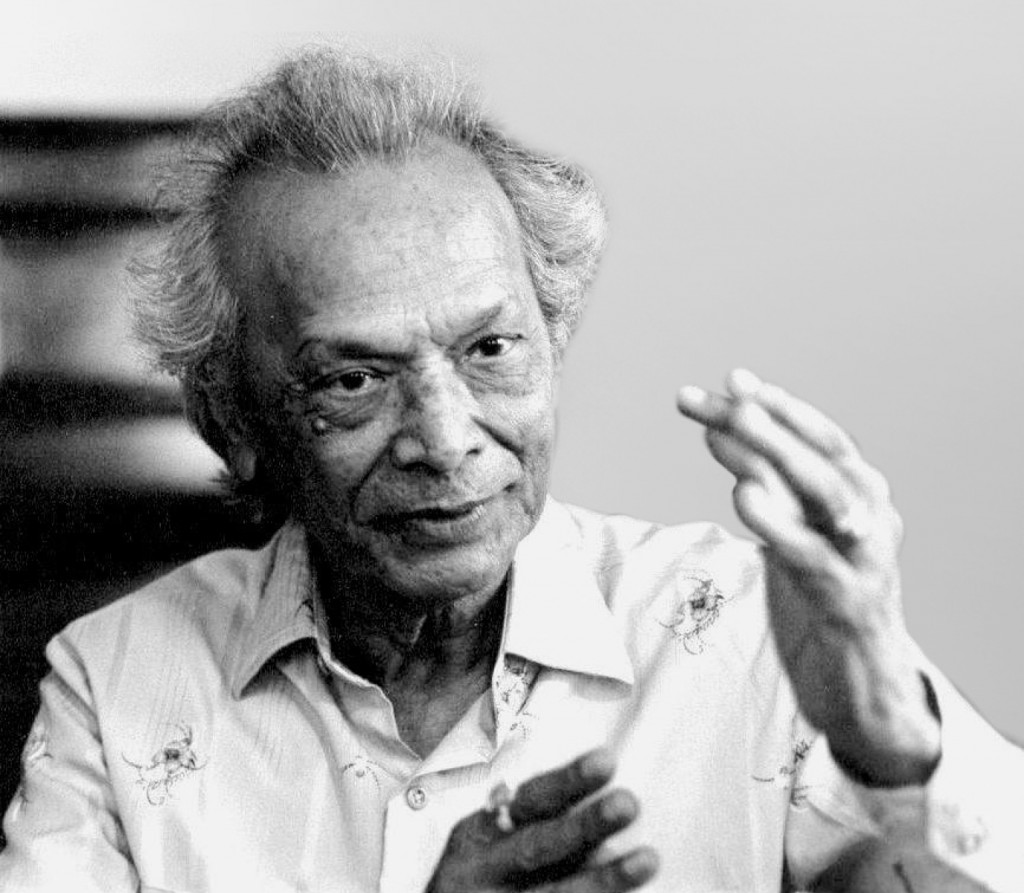In 1946, music maestro Naushad and legendary singer K L Saigal came together for the first time in Shah Jehan. Saigal usually needed a drink of his favourite Black Label before recording a song. Naushad persuaded him to record two versions of the song Jab dil hi toot gaya — both before and after his drink.

Naushad then asked Saigal to listen to the before and after versions and choose one. The dumbfounded Saigal picked the before-drink version and told Naushad: “I wish I had worked with you earlier.”
Saigal wasn’t the only singer whose career Naushad shaped. He mentored Lata, Rafi, Mukesh, Talat, Suraiya, Shamshad Begum, Zohrabai and Uma Devi. It is said that he not merely made great songs, he made great singers.
Even though Naushad composed music for just 65 films, the pristine melody of his songs — many immortal, makes him a colossus of creativity.
Hailed as “sangeet samrat” and Kohinoor of Bollywood music, even though he composed music for just 65 films, the pristine melody of his songs — many immortal, makes him a colossus of creativity. His work was a synthesis of Indian music — classical and folk, ghazals, bhajans and qawwalis. Said S D Burman “It’s from Naushad that composers have learnt how to blend quality with popularity.” But Naushad himself remained humble about his musical prowess. “Allah is the only composer. He lifted me to the skies,” he said once.

He gave Indian cinema three of its great music epics — Baiju Bawra (1952), Mother India (1957) Mughal-e-Azam (1960), and numerous other masterpieces. Just a couple of such films would have conferred stardom on a composer. Together, they constitute a treasure beyond compare. Of his 65 films, 35 celebrated silver jubilee, 12 golden jubilee and three diamond jubilee.
He presented an orchestra of 100 instruments in the film Aan and a chorus of 100 singers for a single song — Ae mohabbat zindabad in Mughal-e-Azam.
He introduced innovations with orchestra, instrumentation and sound that were transformational. He was the first to separately record voice and music tracks in playback singing; the first to combine the flute and the clarinet, the sitar and the mandolin. He also introduced the accordion to Hindi film music and created special rhythms by blending percussion instruments like tabla, dholak and ghatam with the khanjuri. He presented an orchestra of 100 instruments in the film Aan and a chorus of 100 singers for a single song (for Ae mohabbat zindabad in Mughal-e-Azam.) He excelled in the use of background music to create mood and feeling and dramatise the story.

But Naushad’s greatest contribution of course was to create classical music for the masses with tunes they loved. He even brought titans of classicism to cinema. Ustad Amir Khan and Pandit D V Pulaskar sang in Baiju Bawra, and Ustad Bade Ghulam Ali Khan in Mughal-e-Azam.
His best songs
Naushad was considered the man with the Midas touch. He turned everything to music gold!
Examples
- Awaz de, kahan hai — Anmol Ghadi, 1946: A triumphant paean to the power and majesty of Noor Jahan’s voice.
- Tu kahe agar jeevan bhar — Andaz, 1949. Dilip Kumar at the piano captivates heroine Nargis in Mukesh’s voice. Mukesh went to Naushad’s house 23 times to rehearse the song before the maestro okayed it. Mukesh first, then Talat, shone as Dilip’s voice in Naushad’s music, before he settled on Rafi.
- Duniya badal gayi and Mera jeevan sathi bichad gaya — Babul, 1950. Searing melancholy, haunting melody. Talat and Samshad at their best. Filmed on Dilip and Munawar Sultana.
- Dil mein chhupake pyar ka toofan le chaley — Aan, 1951. Naushad had Rafi singing “I love you” in many voices. Here a smiling, teasing Dilip woos a frowning Nadira in Rafi’s vocals.
- Songs of Baiju Bawra, 1952: Three Rafi songs from the movie — Man tapdat hari darshan ko aag; Insan bano; and O duniya ke rakhwale — were testaments to Rafi’s full-throated magnificence and Naushad’s genius. Both wizards soared to the pinnacle of stardom with these songs based on classical ragas, and transformed the Hindi music landscape. Lata’s Mohe bhool gaye sawariyan blended beauty, melody and melancholy. Rafi’s riveting lover’s call Tu ganga ki mauj won Naushad the Filmfare Award for best music of the year.
- When Baiju Bawra celebrated a silver jubilee at Royal cinema, Naushad said, “I used to sleep on the footpath opposite this place. It took me 16 years to cross the road.”
- Songs of Mother India, 1957. This epic presented 12 songs rendered by Lata, Shamshad, Rafi and Manna Dey. Duniya mein hum aaye hain to jeena hi padega and Nagari nagari dware dware are two songs of heart-rending melody by Lata, which capture Nargis’s angst as she battles the iniquities of fate. A few infectious duets and group songs also adorned this titanic movie.
- Pyar kiya to darna kya — Mughal-e-Azam, 1960. Madhubala sets the screen ablaze with a dance that glorifies love and scorns its foes. Lata’s song filmed on Madhubala is as immortal as the film, with a matchless symphony of voice, words and images.
- Mohabbat khi jhooti — Mughal-e-Azam, 1960. The Venus of Indian cinema is in chains. The sangeet samrat and the queen of melody weave magic with this song of despair.
- Mere mehboob — Mere Mehboob, 1963. Rajendra Kumar in Rafi’s mesmerising voice implores the ravishing Sadhana. Naushad immortalised all three with this song!
Naushad was born on Dec 25, 1919, in an orthodox family in Lucknow. Enraptured by movies and music, he often skipped school and went to the Royal cinema in Lucknow. He listened in rapture to the live orchestra that accompanied silent films — it’s here that Naushad the instrumental genius was born. Getting himself a job as a cleaner in an old instruments shop, he played the harmonium on the sly. He was caught red-handed one day, but the shop owner was more impressed than angry at the boy’s talent and gifted him a harmonium.

Naushad learned to play the harmonium from Babbar Khan, the sitar from Ustad Yussuf Ali. But his father was upset at the boy’s craze for music, threw out the harmonium and told him to choose between home and music. Naushad chose music. It was 1937, he was 18.
When Baiju Bawra celebrated a silver jubilee at Royal cinema, Naushad said, “I used to sleep on the footpath opposite this place. It took me 16 years to cross the road.”
The youngster spent some time with an amateur theatrical company that did shows in north and east India, and learnt the folk songs of Punjab, Gujarat, Rajasthan and Saurashtra. When the company folded up, Naushad moved to Bombay — the large city of opportunity where, however, he had no home, no friends, no job.

It was a tough life in Bombay for a few years. Naushad often slept on the footpath opposite Royal cinema. He would walk from Colaba to studios in Dadar in quest of work and did sundry assignments assisting composers. His first break as independent composer came in Prem Nagar (1940). But it was some four years and 10 films later that fortune finally smiled on him. His film Rattan became a blockbuster. Ankhiyan milake sung by Zohrabai Ambalewali was a smash hit. The lovely duet O jaanewale balamwa (rendered by Sham Kumar and Zohrabai) was hummed by one and all. Naushad’s fee soared to ₹25,000 per film.
It was at this time that his parents got him married, telling the bride’s parents that their son was a tailor, hiding his “disreputable” music connection. Ironically enough, the marriage band played songs from Rattan composed by the bridegroom — which he enjoyed in silence!

Anmol Ghadi in 1946 was a superlative triumph. Awaz de kahan hai (a Noor Jehan-Surendra duet) was a sensation, a landmark of Bollywood music. Ajaa meri barbad mohabbatke saharey and Kya mil gaya bhagwan were other unforgettable jewels.
His parents got him married, telling the bride’s parents that their son was a tailor, hiding his “disreputable” music connection. Ironically enough, the marriage band played songs from Rattan composed by the bridegroom — which he enjoyed in silence!
A string of musical masterpieces followed — besides the epics Baiju Bawra, Mother India and Mughal-e-Azam. These included Shah Jehan and Andaz in the 1940s; Babul, Deedar, Shabab. Aan, Amar and Udan Khatola in the 1950s; Kohinoor, Mere Mehboob and Ganga Jumna in the 1960s. Every one of them has several songs of transcendental beauty.

Naushad and Rafi
The Rafi-Naushad pairing was one made in heaven. From Rafi’s first big hit Suhani raat dhal chuki in dulari (1949), he sang 149 songs for Naushad including some 80 solos, and rose to be the most versatile male singer of Bollywood. The two shared a rare empathy, perhaps because they were born on successive days! Rafi was Dilip Kumar’s voice in most Naushad films and gave Bollywood many iconic songs. Rafi went through a period of self-doubt in the 1970s when Kishore Kumar ruled the roost; it was Naushad who shook him out of this phase.

Naushad and Lata
Lata’s voice could electrify or coax, enthrall or titillate. Once Naushad realised her phenomenal talent, she became his No 1 female singer. She sang 160 songs under his baton. Whether it was Uhtaye jaa unke sitam (Andaz), Mohe bhool gaye sawariya (Baiju Bawra), or Dhoondo dhoondo re sajana (Gunga Jumna), Lata’s voice and talent spelled magic. She described Naushad as a perfectionist and said his knowledge was not confined to music. “He is an accomplished piano player, is proficient in Western notations and all instruments.” He was also a poet himself and scrutinised every lyric before composing music for it.

Naushad and Mughal-e-Azam
Mughal-e-Azam was a monument in celluloid, a music epic and Naushad’s greatest triumph. Baiju Bawra had showcased the towering talent of Rafi, but it was Lata who dominated Mughal-e-Azam with eight bewitching songs and a beguiling qawwali with Shamshad. But what was exceptional were two epoch-making songs by Bade Ghulam Ali Khan (Prem jogan ban ke and Shubh din aayo). The Hindustani music legend said he didn’t sing for films and quoted a ridiculously high fee of ₹25,000 per song to put off Naushad and producer K Asif. (Top singers those days were paid ₹500 to ₹1,000 per song.) To his astonishment, Asif responded “Is that all? You are priceless,” and gave him an advance of ₹10,000 on the spot. Rafi had just one song in the film (Mohabbat zindabad) but it was a high-octane stunner, rendered with a chorus of 100 singers.
Ram aur Shyam (1967) was perhaps Naushad’s last success. He did compose a few good songs in Leader (1964), Dil Diya Dard Liya (1966), Sunghursh (1968), Palki (1968), but the creative fire of old was missing. Pakeezah (1972) made waves, with several poignant songs filmed on Meena Kumari, but the credit for its success went to the original composer Ghulam Mohammed. (Naushad completed the music after Ghulam Mohammad’s death.)
This “sangeet samrat” left an indelible mark on Indian cinema as a classical purist with a populist touch, and as the creator of peerless melodies in the 1950s and 1960s and scaled phenomenal heights in popular music. Naushad passed away in 2006. The Dadasaheb Phalke Award (1981) and the Padma Bhushan (1992) were just two of the many honours accorded to him. His legacy lives on.
The author is a senior journalist and a member of the Rotary Club of Madras South






